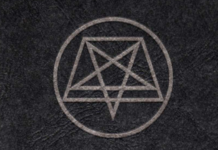
 LeMulGeton: Goetia and the Stellar Tradition, by Leo Holmes
LeMulGeton: Goetia and the Stellar Tradition, by Leo Holmes
Fall of Man Press, 105 pp. (incl. bibliography), 2013
The title LeMulgeton combines the titles of two older books, Lemegeton and MUL.APIN. Written in the 17th century, Lemegeton, otherwise known as The Lesser Key of Solomon, contains a list of 72 demons with sigils and instructions for how to summon them, how each of them appears and their relative strengths. MUL.APIN, on the other hand, is the name of a Babylonian compendium on astronomy and astrology that dates back three thousand years.
When LeMulGeton arrived in my home and I unpacked it, I immediately noticed both its small size and beautiful presentation. It comes in a black card box showing the stars of the constellation of Orion in silver and a red wax seal. Inside we find a plain black paperback book with the full title, LEMULGETON: Goetia and the Stellar Tradition written simply on the cover in a bright silvery grey. Simple, but stylish. The box with wax seal adds a touch of unique style.
Holmes’ book argues that demons in the Lemegeton actually represent a kind of survival of ancient Babylonian star lore. This of course raises some interesting questions in and of itself. If true, how was this lore passed on in the intervening centuries before Lemegeton was written? LeMulgeton only offers a brief speculative discussion on this question, its bulk more concerned with establishing that this knowledge has in fact survived.
The book continues with a list of the 72 demons and discussion concerning which constellation from MUL.APIN they map to. To his credit, Holmes does not try and force any of these correspondences. Where uncertainty exists, he states his preferred correspondence but shares the alternative possibilities, inviting the reader to engage in further research. I found this exploration revealing in that so many of the attributions work so well.
I have also found it useful in my own magical explorations. My fiancée and magical partner, Lolita Perdurabo and I have been evoking spirits we remember contacting us in our childhoods and communicating with them. On Saturday, September 14, 2013, we contacted one of her childhood spirits that had the form of a crocodile. The notes in my diary for this evocation however record that it told me it has appeared to others in the form of an old man. On Sunday, October 27 I was contacted in a dream by a spirit claiming to be connected to the star Algol. Algol is a star in the constellation of Perseus, which Holmes tells us is the Sumerian constellation SU.GI or the Old Man. This refers to Anu, who represents the dome that covers the flat earth. Outside this dome lives Tiamat, depicted variously as a dragon, a crocodile or other reptilian monsters. Holmes equates this to the Goetic demon Agares, a fair old man who rides a crocodile. Thanks to Holmes’s book I was able to connect my dream to a previous evocation, and obtain correspondences between spirits we evoked with ancient deities and a Goetic demon!
Stellar magick such as described in this book provides much fertile material for magicians working some form of UFO paradigm, ultraterrestrial or otherwise. This doesn’t escape Holmes’ attention and he briefly discusses the CE5 techniques used by CSETI (the Centre for the Study of Extraterrestrial Intelligence) as a form of evocation. CE5 means Close Encounters of the Fifth Kind, and essentially refers to human initiated contact. Evocation in magical terminology. The CSETI group themselves use a combination of laser pointers and remote viewing type techniques to summon UFO encounters. Leo proposes similar techniques to communicate with goetic spirits outdoors via their constellations.
Holmes also compares the sigils of some goetic demons with the shape of their corresponding constellations via side by side illustration of three examples. Those so chosen for this task, of Bael with Taurus, Zagan with Aquarius and Buer with Sagittarius are quite striking. The reader might wander if the other 69 match quite as well. Looking at my own example above I can certainly make out a similarity between Perseus and Agares, when I factor in how the crescent like arc of the milky way intersects with the constellation. He also discusses star lore in tarot, the writings of Aleister Crowley and Kenneth Grant, the fiction of H.P. Lovecraft, Middle Eastern traditions and the Hebrew alphabet. These seem scholarly and well researched, and offer the reader sources of inspiration for how the book might actually be used.
The highest accolade I can give a book these days is to say reading it has had an actual impact on my magical practice. This book has definitely achieved that. My journey with contact with Agares continued with a star gazing meditation on January 20, 2014, a deliberate evocation of Agares on the 25th January and a pariedolic manifestation of Agares on a trip to Clava Cairns, so strong that for a while I was absolutely convinced there really was an old man present. Lolita actually had to convince me that he wasn’t really there. During my journey with this entity I have found that my communication skills are greatly improving. Agares is said to teach all languages, and it seems this includes the use of language also. LeMulgeton has proved invaluable in making this connection.








